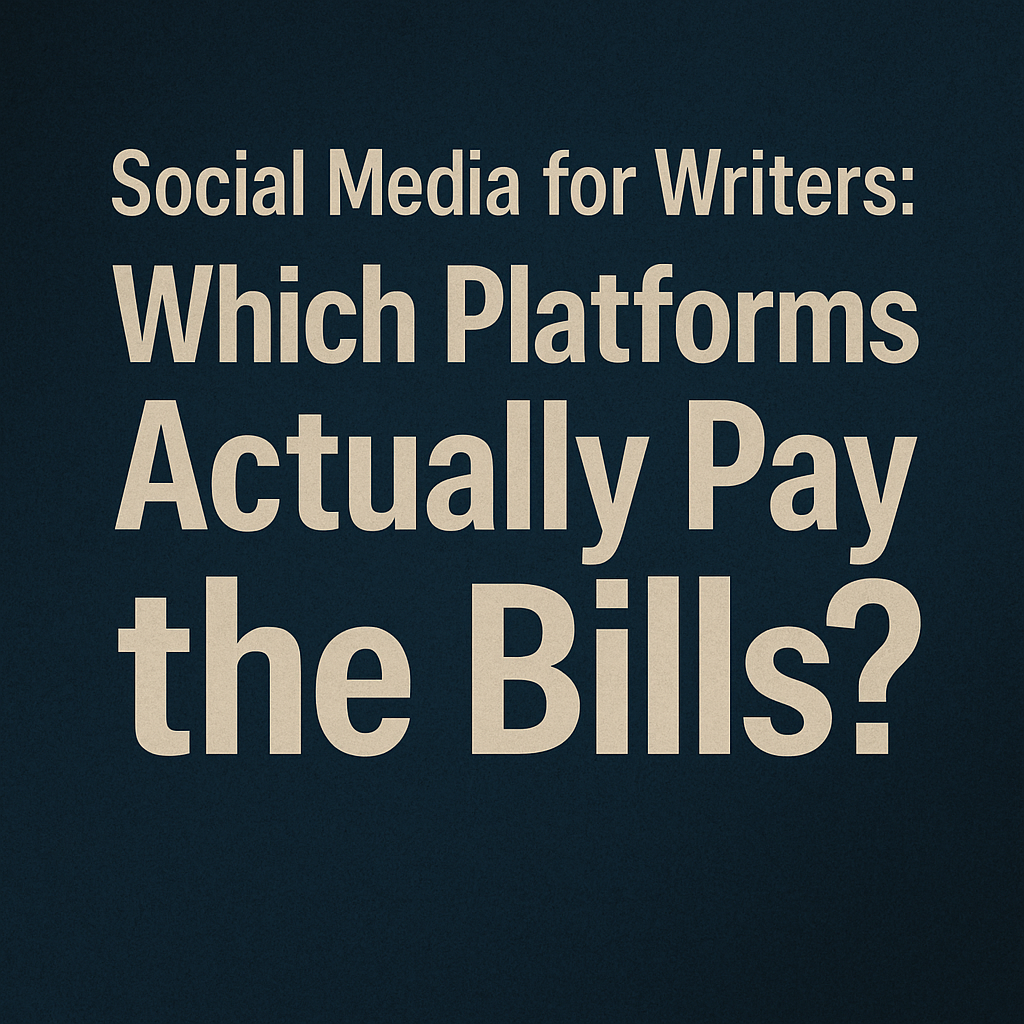Every writer faces the same dilemma: Which social media platforms are worth your precious writing time?
While your writing friends chase follower counts and celebrate viral posts, smart writers focus on platforms that generate real opportunities. The difference between writers who struggle to find clients and those who have waitlists often comes down to one thing: strategic platform choice.
This guide analyzes engagement rates, conversion data, and real-world case studies to reveal which platforms deliver measurable results for writers.
What you’ll discover:
- Where successful freelance writers land their highest-paying clients
- Which platforms convert followers into book buyers (and which don’t)
- The surprising ROI data that will change how you think about social media
- A simple framework to choose your primary platform in under 5 minutes
What Real ROI Looks Like for Writers
Forget vanity metrics. Here’s what actually matters:
✅ Direct client inquiries – Messages that lead to paid work
✅ Book/content sales – Traffic that converts to revenue
✅ Speaking/teaching opportunities – Invitations that expand your income
✅ Media mentions – Journalists who quote you as an expert
✅ Newsletter subscribers – Engaged readers who buy your work
If your social media strategy doesn’t generate these outcomes, you’re building someone else’s business, not yours.
Platform ROI Analysis: The Data-Driven Breakdown
LinkedIn: The Freelancer’s Gold Mine
The Numbers:
- Writers who post consistently get 3x more inbound client inquiries (LinkedIn internal data)
- B2B writers report average project values 40% higher from LinkedIn leads vs. other platforms
- Posts have a 24-hour engagement window (vs. 18 minutes on Twitter)
Why It Works: LinkedIn users are in “business mode” – they’re actively seeking solutions and have budgets to spend. Decision-makers scroll LinkedIn during work hours, not leisure time.
Best Content Strategy:
- Share client wins (with permission)
- Break down complex topics into digestible insights
- Comment meaningfully on industry leaders’ posts
- Use polls to spark engagement
Ideal For:
- B2B copywriters and content marketers
- Technical writers and consultants
- Business book authors and ghostwriters
Twitter/X: The Journalist’s Network
The Numbers:
- Active journalist Twitter users report 40% more story assignments (Muck Rack survey)
- Well-crafted threads can generate 10x more newsletter signups than single tweets
- Engagement rates highest between 9-10 AM EST on weekdays
Why It Works: Editors, agents, and media professionals use Twitter to discover new voices and track breaking stories. The platform rewards timely, intelligent commentary.
Best Content Strategy:
- Live-tweet industry events and conferences
- Share contrarian takes on trending topics (respectfully)
- Create educational threads about your expertise
- Engage with blue-check journalists in your field
Ideal For:
- Journalists and political commentators
- Essay writers and opinion columnists
- Authors seeking traditional publishing deals
TikTok: The Fiction Writer’s Fast Track
The Numbers:
- BookTok videos drive 60% of Gen Z book purchases (NPD Group)
- Fiction authors with viral TikToks see average sales increases of 300%
- Romance and fantasy genres perform best (82% of BookTok purchases)
Why It Works: TikTok’s algorithm gives new creators equal opportunity to reach massive audiences. Book recommendations from authentic users carry more weight than traditional marketing.
Best Content Strategy:
- Create “books that made me cry” compilations
- Show your writing process (aesthetically pleasing setup required)
- React to book tropes and reading trends
- Collaborate with BookTok influencers
Ideal For:
- YA, romance, and fantasy authors
- Writers comfortable with video content
- Authors targeting readers under 30
Instagram: The Brand Builder’s Platform
The Numbers:
- Authors with 10K+ engaged Instagram followers sell 25% more books than those without
- Story features generate 3x higher engagement than feed posts
- Publishing industry professionals actively scout Instagram for new talent
Why It Works: Instagram’s visual nature allows writers to build personal brands and showcase personality. Readers connect with authors they feel they “know.”
Best Content Strategy:
- Behind-the-scenes writing life content
- Quote graphics from your work
- Book flat-lays and reading recommendations
- Instagram Stories for real-time updates
Ideal For:
- Memoir and lifestyle writers
- Poetry and creative nonfiction authors
- Writers building personal brands
YouTube: The Long-Term Investment
The Numbers:
- Top writing education channels earn $10K-$50K monthly from ads and sponsorships
- Tutorial videos maintain views for 2-3 years after publication
- Subscribers convert to email list at 15% rate (vs. 3% from other platforms)
Why It Works: YouTube functions as the world’s second-largest search engine. Writers searching for craft advice will find and follow helpful channels for years.
Best Content Strategy:
- “How to write [specific thing]” tutorials
- Book reviews and writing craft discussions
- “Day in the life of a writer” vlogs
- Live writing sessions and Q&As
Ideal For:
- Writing coaches and educators
- Authors comfortable with long-form video content
- Writers building authority in specific niches
Platforms That Drain Time Without Results
Facebook: Organic reach has plummeted to less than 2%. Unless you’re running paid ads, your content won’t be seen.
Pinterest: Only effective for very specific niches (romance novels, writing journals). Requires consistent, high-quality graphics.
Reddit: Great for research and community, terrible for self-promotion. Most writing subreddits have strict anti-promotion rules.
Clubhouse: The audio social trend has largely faded. Time investment rarely translates to meaningful opportunities.
The 5-Minute Platform Selection Framework
Step 1: Define Your Primary Goal
- Land freelance clients → LinkedIn
- Build readership for fiction → TikTok/Instagram
- Establish thought leadership → Twitter/LinkedIn
- Create passive income → YouTube
Step 2: Assess Your Content Strengths
- Love writing long-form? → LinkedIn
- Comfortable on video? → TikTok/YouTube
- Strong visual aesthetic? → Instagram
- Quick with witty commentary? → Twitter
Step 3: Consider Your Time Investment
- 30 minutes daily → Twitter
- 1 hour daily → LinkedIn/Instagram
- 3+ hours weekly → YouTube
- Sporadic posting → Instagram Stories
Step 4: Match Your Audience
- B2B decision-makers → LinkedIn
- Young adult readers → TikTok
- Industry professionals → Twitter
- Lifestyle/memoir readers → Instagram
Implementation Strategy: The 90-Day Plan
Days 1-30: Foundation
- Optimize your chosen platform’s profile completely
- Study top performers in your niche
- Post consistently (daily for Twitter, 3x/week for others)
- Engage authentically with your target audience
Days 31-60: Content Refinement
- Analyze which content types get best engagement
- Double down on what works, eliminate what doesn’t
- Begin engaging with industry influencers
- Start tracking leads/opportunities generated
Days 61-90: Scale and Systematize
- Create content templates for efficiency
- Set up systems to track ROI metrics
- Begin collaborating with other creators
- Consider expanding to one additional platform
Common Mistakes That Kill Writer ROI
The Spray and Pray Approach: Posting randomly across multiple platforms instead of mastering one.
Vanity Metric Obsession: Celebrating follower milestones while ignoring actual business results.
Selling Too Soon: Promoting your work before building genuine relationships and providing value.
Inconsistent Presence: Posting sporadically then wondering why engagement drops.
Wrong Platform Match: B2B writers wasting time on TikTok, or fiction authors focusing solely on LinkedIn.
Key Takeaways
✔ LinkedIn dominates for freelance client acquisition – particularly in B2B niches
✔ TikTok drives the most book sales – especially for fiction targeting younger readers
✔ Twitter remains essential for journalists – and anyone seeking media opportunities
✔ YouTube offers the best long-term passive income potential – but requires significant upfront investment
✔ Instagram works for personal brand building – particularly for lifestyle and memoir writers
The Bottom Line: Choose one platform, master it completely, then consider expanding. Writers who focus their efforts always outperform those who spread themselves thin.
Your Action Step: Pick your primary platform today. Set up proper analytics tracking. In 90 days, you’ll have clear data on what’s working and what isn’t.
Which platform will you choose? What’s your biggest social media challenge as a writer? Share in the comments below – I read every response and often feature the best questions in future articles.
Want weekly insights on building a profitable writing career? Subscribe to our newsletter and join 10,000+ writers who are turning their craft into sustainable income.

Data-driven editor at CliqSpot, transforming raw analytics into actionable growth strategies for modern businesses.

Leave a Reply